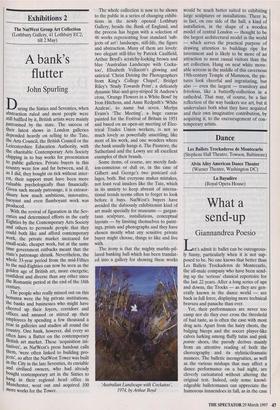Dance
Les Ballets Trockaderos de Montecarlo (Stephens Hall Theatre, Towson, Baltimore) La Bayadere (Royal Opera House)
What a send-up
Giannandrea Poem()
Let's admit it: ballet can be outrageous- ly funny, particularly when it is not sup- posed to be. No one knows that better than Les Ballets Trockaderos de Montecarlo, the all-male company who have been send- ing up the 'serious' classical repertoire for the last 22 years. After a long series of ups and downs, the Trocks — as they are gen- erally known in the dance world — are back in full force, displaying more technical bravura and panache than ever.
Yet, their performances are never too camp nor do they ever cross the threshold of bad taste, as is often the case with most drag acts. Apart from the hairy chests, the bulging biceps and the soccer player-like calves lurking among fluffy tutus and pink pointe shoes, the parody derives mainly from an attentive reading of both the choreography and its stylistic/dramatic nuances. The balletic incongruities, as well as the various mishaps that may affect a dance performance on a bad night, are cleverly caricatured without altering the original text. Indeed, only some knowl- edgeable balletomanes can appreciate the humorous innuendoes in full, as in the case of the pas d'action from Esmerelda, where the parody highlights and accentuates the kitsch elements of Petipa's creation, or in the case of the 'Pas des Odalisques' from Le Cotsaire, which mocks the mannerism of some well-known contemporary Russian dancers. The lack of stylistic and historical awareness, however, does not prevent the non-balletomanes from enjoying the per- formance. The second act of Swan Lake has a powerful comic immediacy that tran- scends the humorous choreographic and historical references; similarly, the Trocks' 'Dying Swan' — complete with falling feathers — does not require a thorough knowledge of the work and of its illustrious interpreters to be appreciated.
On a more serious level, stamina, panache and, to a certain extent, humour are also characteristics of the Alvin Ailey American Dance Theater. Under the enlightened directorship of the former dancer Judith Jamison, the company has reached amazingly high standards both technically and artistically. These qualities allow the dancers to swap from one chore- ographic genre to another with admirable eclecticism and ease. Together with well- established creations such as Otis Suite Cry or the enthralling Revelations — Alley's sig- nature piece — the current repertoire of the company includes works by Lar Lubovitch and Hans Van Manen which dif- fer considerably in style and content. Even when the choreographic layout is rather unflattering, as in the case of Van Manen's Polish Pieces, the dancing is outstanding.
I wish I could show similar enthusiasm for the Royal Ballet's La Bayadere. I have always had reservations about this produc- tion, originally staged by Natalia Makaro- va. Unlike Rudolph Nureyev's version for the Paris Opera Ballet, the Royal Ballet's Bayadere lacks that operatic grandeur and that sumptuous old good 'bad' taste that allegedly characterised the work of Marius Petipa. Despite the beautiful costumes by Yolanda Sonnabend and the lavish sets by Pierluigi Samaritani, this Bayadere looks like a 'chamber version' of the same ballet.
Indeed, Makarova's idea of curtailing several extra character dances from Act I, the grand parade of marching extras pre- scribed by Petipa in his choreographic notes and some of the Shades in Act II, was for practical reasons. Yet, Bayadere relies heavily on its spectacular quality, for its story is merely a flimsy pretext for some beautiful choreography.
Personal preferences notwithstanding, last Saturday's performance was marred by a series of annoying incidents. Lights went on and off when they shouldn't have done, a little torch was dropped on the stage dur- ing the supernatural act and the sets refused to work properly — the big Bud- dha in Act III cracked in half, a few min- utes before the final catastrophe, and the backcloth of the final scene remained stuck on his head. In addition, the corps de ballet looked out of shape and lacked that co- ordination required for any Petipa ballet. These flaws were particularly evident in the third act, the Kingdom of the Shades, where perfect symmetry is the key element. Wobbling legs, uneven spaces and a certain tendency to be out of time with the music spoilt the magical atmosphere of Petipa's most famous scene. Among the principal dancers Darcey Busse11 stood out for both her technique and majestic portrayal of the evil princess, while Tetsuya Kumakawa brought the house down as the Bronze Idol. Jonathan Cope, as the lovelorn hero, looked dramatically unconvincing, while Sy'vie Guillem, a favourite of the audience, was simply miscast as the heroine Nikiya — there is more to that role than hyper extended legs. Still, as I have said, it was a bad night and I am sure that future perfor- mances will look much better.



































































 Previous page
Previous page